Peer-Reviewed Topical Review: The Importance of Quality in Corrosion-Resistant Alloys in Biopharmaceutical Manufacturing
In this topical review, the authors discuss the rationale behind microstructural requirements for biopharmaceutical equipment and problems that may be encountered during the fabrication of high-performance corrosion-resistant equipment.
The cost of corrosion of pharmaceutical equipment can be significant, and ways to mitigate these costs are important to the industry. A recent report, Corrosion Costs and Preventive Strategies in the United States (1), provides an estimate of the total economic impact of metallic corrosion and identifies national strategies to minimize the impact of corrosion.The study estimates the direct cost of corrosion in the United States at $276 billion, or roughly 3% of the US gross domestic product (GDP). Indirect costs of corrosion are conservatively estimated to be equal to the direct cost, resulting in a total direct and indirect impact of corrosion of approximately $551 billion annually, or 6.3% of the GDP.
For the pharmaceutical manufacturing industry, total capital expenditures are approximately $4.5 billion with up to $0.5 billion per year in corrosion costs. This figure does not include the indirect costs because of the unexpected loss and downtime of critical equipment and its effect on inventories and production scheduling. In the biotechnology sector, the indirect cost can be 10–20 times more than the direct cost. Consider a scenario where one batch of final product has to be discarded because of metal-catalyzed damage to the protein. For example, a 120-L final product vessel constructed of stainless steel 316L (UNS S31603) costing $30,000 and an alloy of nickel–chromium–molybdenum such as C-22 (UNS N06022) costing $60,000 holds bulk product worth $1 million. If one such batch has to be discarded due to the corrosion of 316L, the production cost is lost as is any potential revenue and profit from the drug product. Avoiding the loss of even one single batch easily covers the extra capital expenditure of using more corrosion-resistant materials to ensure no loss of production.

PHOTO IS COURTESY OF DCI INC.
Another incentive to use more corrosion-resistant materials is to ensure compliance to federal regulations. Title 21 CFR Parts 210 and 211, "Current Good Manufacturing Practice In Manufacturing, Processing, Packing or Holding of Drugs; General and Current Good Manufacturing Practice For Finished Pharmaceuticals," Subpart D-211.65 states:
Equipment shall be constructed so that surfaces that "contact components, in-process materials, or drug products shall not be reactive, additive, or absorptive so as to alter the safety, identity, strength, quality, or purity of the drug product beyond the official or other established requirements (2)."
This regulation clearly implies corrosion of equipment or product contamination of any kind is not acceptable.
Fabrication of vessels
The fabrication of vessels made of austenitic stainless steels and the higher corrosion-resistant materials such as the superaustenitic and nickel alloys are the same in many ways, but there are some differences. The obvious difference is the higher value of the raw material being used to fabricate the vessels. There are also the basic welding, forming, and polishing differences. The more important issue, however, is that the vessels made of these higher alloys are generally used in more critical applications with regard to corrosion resistance, some of those being final product or "payload" vessels where the value of the product in these vessels are much higher than any other. The vessels made of these higher alloys are expected to be at a minimum equivalent in surface-finish characteristics to austenitic stainless steels. By meeting this requirement, the cleaning and sterilization will be equivalent to known practices and the higher corrosion resistance will be automatic. Overall, the surface-finish quality and corrosion resistance must be at a premium. If there are any problems encountered during manufacturing of the vessels that do not allow this premium quality to be achieved, it hampers fabrication schedules, which can in turn affect a company's schedule of getting a drug to market. There are also major cost effects of raw materials and shop labor that the vessel manufacturer has put into the product.
The fabrication of these high-alloy vessels begin with the normal purchase of raw materials. The lead times of these raw materials are generally longer than the austenitic stainless steels, and it is important to have the correct material specifications at this stage. Raw materials are received into the fabrication shop normally in the mill hot-rolled, annealed, and descaled condition, but on occasion are in a cold-rolled 2B type finish. The material is thoroughly inspected. Raw-material markings are checked, and material certifications are received and reviewed for compliance. Positive material identification is performed to verify the correct material chemistry. After inspection, components such as vessel heads, liners, heat-transfer coils, and heat-transfer jackets are cold-formed and prepared for welding. Welding is performed in compliance with the applicable code and customer specifications; typically for the American Society of Mechanical Engineers' (ASME) Section VIII, Division I code vessels, ASME Section IX is required (3, 4). Welding of the shells, heads, nozzles, and heat-transfer surfaces are performed. After welding, many forms of mechanical polishing steps are performed to remove any mill hot-rolled, annealed, and pickled finish, weld beads, and weld-heat tint to achieve a uniform, flush, and smooth surface finish. Much of this work is performed at the component and subassembly stage. Many inspections of welds and surface finishes are performed during this process to comply with customer requirements and the ASME bioprocessing equipment standard (5).

Figure 1: (COURTESY OF DCI INC.)
The final stage is electropolishing of the vessel components and subassemblies. At this stage, the final surface finish is achieved and inspected. If it does not meet the requirements and if it is found to be a raw-material metallurgical issue, the surface finish generally cannot be changed. This situation becomes a major issue for the vessel manufacturer, raw-material suppliers, and mostly the vessel purchaser. Depending on the vessel, 70–90% of the fabrication costs may be already performed at this point. Normally there are only a few final fabrication steps left such as installation of components and subassemblies into the vessel and finally the insulation and exterior sheathing. In addition, there may be some final factory-acceptance testing to be performed. Figure 1 shows the highly electropolished heat-transfer coils for a vessel. A completed biopharmaceutical vessel is shown in Figure 2.

Figure 2: (COURTESY OF DCI INC.)
High-performance corrosion-resistant materials
Stainless steel 316L has traditionally been the workhorse of the biopharmaceutical industry. Because of more demanding applications and the unforeseen decrease in the quality of 316L stainless steel due to chemistry changes and heat-treatment practices, end users have been selecting higher performance corrosion-resistant alloys for many new applications.
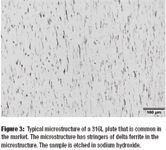
Figure 3: (COURTESY OF AUTHORS.)
Microstructure quality is a major issue with 316L stainless steel. Figure 3 shows the typical microstructure of the 316L plate that is currently on the market. This microstructure consists of bands of delta ferrite stringers. Figure 4 shows the microstructure of a 316L bar product that contains large stringers of manganese sulfide inclusions. The metallurgical quality of alloys is an important issue since it has a direct impact on the corrosion resistance and therefore on product contamination. The presence of discontinuities on surfaces resulting from removal of inclusions that intersect the surface can release contaminants that in turn affect product quality and yields. Since most equipment destined for biopharmaceutical applications needs to be of good quality, it is essential to have a pit-(mechanical-) free surface.
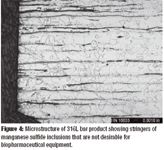
Figure 4: (COURTESY OF AUTHORS.)
Over the past 10 years, increased use of high-performance corrosion-resistant alloys has involved superaustenitic stainless steels, commonly referred to as 6% moly alloys and nickel base alloys in the family of nickel–chromium–molybdenum alloys. The most common alloys in these groups are AL6XN (UNS N08367) and Alloy 22 (UNS N06022). Table I shows the typical composition of some high performance alloys used in the industry.

Table I: The chemical composition ranges of some of the alloys used in the biopharmaceutical industry.
The melting and processing method for each alloy can vary, which can ultimately affect the metallurgical and corrosion performance of the alloy. The alloys listed in Table I are generally produced in electric arc or induction furnaces. From the electric-arc furnace, the molten and precarburized heat is transferred in the liquid state either to an argon oxygen decarburized (AOD) converter, vacuum induction melter (VIM) or to a vacuum oxygen decarburized (VOD) unit. In the AOD and VOD, the alloying elements additions are adjusted, and the carbon content is reduced to less than 0.03%. After decarburization and deoxidation, extensive desulfurization is also done in the AOD and VOD processes. To achieve low-segregation characteristics of the ingot, subsequent electro-slag remelting or remelting in a vacuum-arc furnace is necessary.
Generally, AL-6XN (UNS N08367) and 254SMO (UNS S31254) alloys are produced using a continuous cast method where the slabs are bottom-poured continuously from the AOD furnace. This technique can result in significant segregation of intermetallic phases in some of the slabs.
The alloying elements in the superaustenitic stainless steels must be in solid solution to maintain optimum corrosion resistance and fabricability of these alloys. Precipitation of intermetallic compounds, particularly sigma, but also chi and Laves phases, in the superaustenitic alloys can result in depletion of chromium and molybdenum in adjacent areas. These areas can serve as sites for pitting and, in some cases, intergranular corrosion. For high-purity applications, these alloys must undergo electro-slag remelting to avoid the segregation effects.
Almost all nickel–chromium–molybdenum alloys are poured from the AOD furnace into ingots and subsequently electro-slag remelted. These alloys are expected to have good microstructure. Because of thermomechanical-processing problems, however, these materials have shown tendencies to form intermetallic phases that are deleterious to corrosion resistance and electropolish quality.
The need for electropolishing
The 300-series type stainless steels are often electropolished and passivated primarily to improve their corrosion resistance and cleanability. It can be argued that the high performance corrosion-resistant alloys do not need to be electropolished and passivated because the higher alloying content provides adequate corrosion resistance. Passivation procedures that are used to form a uniform passive film to enhance corrosion resistance are not necessary with the higher alloys. Electropolishing, however, is often specified for the high-performance alloys. Mechanically finished surfaces produce a cold worked surface and damaged layer that includes scratches, lapping, and gouges with possible embedded abrasive compounds. Electropolishing is used to remove this layer and impart a surface that is microscopically featureless and clean. It substantially reduces product contamination and adhesion as electropolishing reduces the effective active surface area on the metal surface and removes material imperfections such as inclusions. Overall, electropolishing allows better cleaning, sanitization, and sterilization, thereby, lowering cleaning costs, allowing easier validation that minimizes the potential for product contamination, along with lowering future maintenance costs.
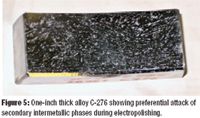
Figure 5: (COURTESY OF AUTHORS.)
Since electropolishing is a form of corrosion, any microstructural defects are preferentially corroded leading to an undesirable surface finish.

Figure 6: (COURTESY OF AUTHORS.)
Microstructure quality deficiency
Over the past few years, several cases have been reported where vessels fabricated using the high-performance alloys showed a visual "hazing," frosting, or whitening of the surface (6). Figures 5 and 6 show some of the extreme cases of inadequate surface characteristics obtained after electropolishing the nickel–chromium–molybdenum alloy UNS N10276 plate. Figures 7 and 8 show the surface of an UNS N08367 plate after electropolishing. It is clear that the surface appearance in all these cases is due to the preferential corrosion of secondary phases in the microstructure. The defects have been observed on various product forms, including sheet, plate, tube, pipe, bar, and forgings. The defects are not limited to alloy N10276, but have been observed in UNS N06022, UNS N06200, UNS N06686 (Alloy 686), and UNS N06059 (Alloy 59) and also the superaustenitic stainless steels UNS N08367, UNS S31254, and UNS N08926 (Alloy 25-6Mo).
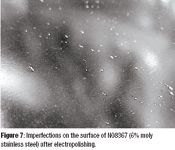
Figure 7: (COURTESY OF AUTHORS.)
To determine the root cause of the deficiency observed during electropolishing, samples from the various alloy plates were cross-sectioned, and the microstructure evaluated. The montage of photomicrographs shown in Figure 9 show the microstructure of the various nickel–chromium–molybdenum alloys that cause undesirable electropolish quality and make these microstructures unacceptable for fabrication of biopharmaceutical equipment.

Figure 8: (COURTESY OF AUTHORS.)
Figures 9a and 9b show the microstructure of the alloy N10276 that led to the deficiency in the electropolishing shown in Figure 5. The microstructure consists of significant banding, thought to be a result of precipitation of topologically close-packed intermetallic phases, mainly μ-phase. The μ-phase is a molybdenum-nickel rich phase containing chromium, tungsten, and iron. The microstructure clearly shows that the segregated μ-phase microstructure intersects the surface of the plate. Due to the difference in the composition between the μ-phase and the surrounding matrix region, a potential difference exists between the two regions leading to preferential attack of the more active component, μ-phase. It is not surprising that the metal surface did not exhibit brilliant luster and reflectivity. Electropolishing is essentially a mild corrosion process, and any inhomegeneity in the microstructure of the alloy at the surface will result in preferential corrosion.

Figure 9: (COURTESY OF AUTHORS.)
The photomicrographs in Figure 10 show the morphology of the intermetallic phases observed in the 6% moly (UNS N08367) plate material. In the 6% moly superaustenitic alloys, the two principal elements that improve corrosion resistance, chromium, and molybdenum, also participate in the formation of many of the damaging intermetallic phases that form in these alloys. Sigma phase is the primary phase that affects the corrosion resistance and mechanical properties. Because high chromium and molybdenum are an essential feature, minimizing the occurrence of sigma phase can be a significant factor in the successful production and fabrication of the 6% moly superaustenitic alloys. All these grades were developed to be free of sigma phase in the solution-annealed condition. Traces of sigma are not uncommon in solution-annealed austenitic grades because of segregation in the starting cast slab or ingot. Homogenization heat treatments and electro-slag refining is important in minimizing the formation of sigma phase.

Figure 10: (COURTESY OF AUTHORS.)
Fortunately, both the nickel–chromium–molybdenum alloys and the 6% moly superaustenitic alloys can be produced with excellent microstructure if the mills take the necessary steps in controlling chemistry and using the appropriate melt technology and thermomechanical processing. Figure 11 shows the microstructure of an UNS N06022 plate that has an excellent clean microstructure. This type of microstructure has electropolished well and will perform to the desired requirements for the biopharmaceutical industry.
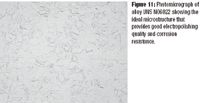
Figure 11: (COURTESY OF AUTHORS.)
For the biopharmaceutical industry, it is prudent that the microstructure of the alloy be checked and samples of the alloys electropolished before fabrication of equipment is contemplated. In addition, significant testing should be done on new alloys that are introduced to the biopharmaceutical industry.
Hira Ahluwalia, PhD, is president of Material Selection Resources, Pennington, NJ 08534, hira@doctormetals.comBrian J. Uhlenkamp* is vice-president of engineering and research and development at DCI Inc., 600 North 54th Ave., St. Cloud, Minnesota 56303, tel. 320.252.8200, bjuhlenkamp@dciinc.com
* To whom all correspondence should be addressed.
Submitted: Jan. 20, 2008. Accepted Jan. 31, 2008.
References
1. Corrosion Costs and Preventive Strategies in the United States, Transportation Equity Act for the 21St Century (TEA-21), US Congress, 1998.
2. Code of Federal Regulations, Title 21, Food and Drugs.
3. American Society of Mechanical Engineers (ASME) Section VIII Div. 1, Boiler and Pressure Vessel Design Code (ASME, New York, 2007).
4. American Society of Mechanical Engineers (ASME) Section IX, Welding (ASME, New York, 2007).
5. American Society of Mechanical Engineers (ASME) Bioprocessing Equipment (ASME, New York, 2005).
6. H. Ahluwalia and B. Uhlenkamp, "The Influence of Microstructures in the Fabrication and Electropolish Finish of Corrosion Resistant Equipment for the BioPharmaceutical Industry," presented at Corrosion 2007, National Association of Corrosion Engineers, Nashville, TN, March 2007.

Drug Solutions Podcast: A Closer Look at mRNA in Oncology and Vaccines
April 30th 2024In this episode fo the Drug Solutions Podcast, etherna’s vice-president of Technology and Innovation, Stefaan De Koker, discusses the merits and challenges of using mRNA as the foundation for therapeutics in oncology as well as for vaccines.
Pharmaceutical Tariffs Are Imminent: How Industry is Bracing for Impact
April 16th 2025On April 14, 2025, the Trump Administration launched a national security-driven investigation into pharmaceuticals, a move that will likely result in tariffs being placed on pharmaceutical drugs, ingredients, and other components that are imported from outside of the United States.